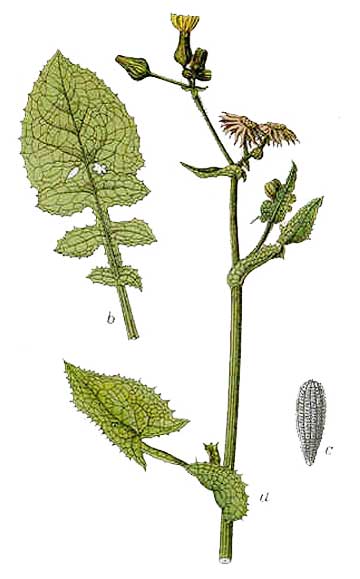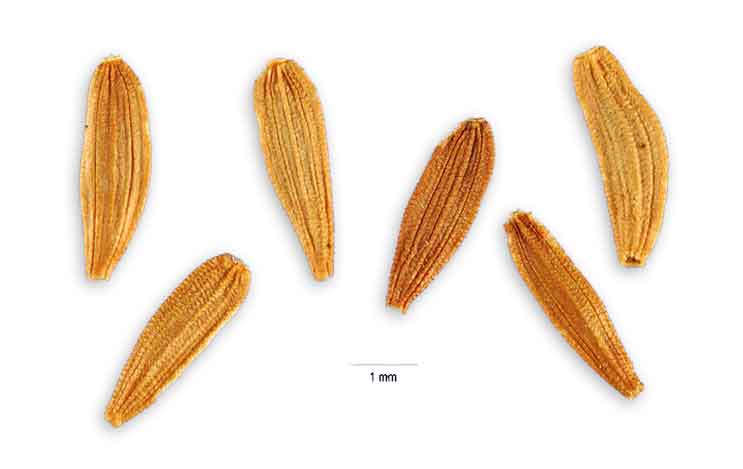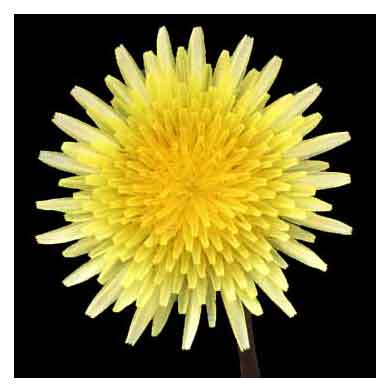 Etymology Etymology
The common name 'sow thistle' derives from its attractiveness to swine and the similarity of its leaf to the pig's ear. The scientific name's latin roots are: sonchus, hollow stem and oleraceus, delectable nature, herb used in cooking.
Botany
Gagatang is an erect, annual, milky, hairy or slightly glandular herb, growing 40 to 80 centimeters high. Leaves are oblong to lanceolate, 10 to 20 centimeters long, coarsely and lyrately lobed; the lobes somewhat reflexed and toothed, the terminal ones large, the lateral one pointing downwards, and those of the stem clasping at the base. Heads are peduncled, about 1 centimeter long. Bracts are smooth, thin and green. Flowers are numerous and yellow. Achenes are nearly 3 millimeters long, compressed, ribbed and rough.
Distribution
- Found only in the Benguet subprovinces, Rizal and Laguna provinces in Luzon.
- In waste places, along trails, old gardens, on talus slopes at altitudes of 1,200 to 2,000 meters.
- Occurs in all warm countries.
Constituents
- Reported to contain the same constituents as S. arvensis.
-
Contains fixed oil with stearic and palmitic acids, ceryl-alcohol, invert sugar, choline, tartaric acid.
- Milky juice contains oxydase, coautchoue, mannite, l-inosite, etc.
- Phytochemicals of aqueous extracts yielded sugar reducers, phenolic compounds, tannins, flavonoids and coumarins.
- Study yielded four sesquiterpene glycosides - sonchusides A, B, C and D together with five known glycosides - glucozaluzanin C, macrocliniside A, crepidiaside A and picrisides B and C. (7)
- Study for chemical constituents yielded four compounds: p-methoxyphenylacetic acid (1), luteolin (2), apigenin (3), quercetin-3-O-glucoside (4). (26)
- Preliminary screening of various extracts of crude powdered drug yielded cardiac glycosides, steroid, tannins, phenolic compound, flavonoid, and carbohydrate. (see study below)
(28)
Parts used
Stem, leaves, gum, juice.

Uses
Folkloric
- Brownish gum formed by the evaporation of the common sow thistle, when taken internally in a dose of two to four grains, acts as a "powerful hydragogue cathartic" with strong effects on the liver, duodenum and colon. Its effects resemble elaterium, producing large and watery discharges, thus an effective agent in ascites and hydrothorax. However, it may cause griping like senna and produce tenesmus like aloes. To counteract that effect, the gum is administered with manna, aniseed, and carbonate of magnesia, or with stimulants and aromatics
- Natives of Bengal use an infusion of leaves and roots as tonic and febrifuge.
- In Indochina, stems used as sedative and tonic.
- In Italy, used as a laxative and diuretic.
- Juice of the plant used for cleaning and healing ulcers.
- In Brazilian folk medicine, used as a general tonic. Also used in the treatment of headaches, general pain, hepatitis, infections, inflammation and rheumatism. (18)
- In India juice of fresh leaves taken orally every morning for hepatotropic / hepatoprotective. (30)
 Studies Studies
• Antidepressant: Study of S oleraceus extracts in mice showed evidence of an antidepressant-like effect comparable to that of amitriptyline (10mg/K p.o.). (2)
• Antinociceptive: Extracts of SO markedly demonstrated antinociceptive action in mice, supporting previous claims of traditional use. At 300 mg/kg, it had a stronger antinociceptive effect than indomethacin (5 mg/kg) and morphine (10 mg/kg). (3)
• Anxiolytic: Study of extract of aerial parts showed anxiolytic effects in mice similar to clonazepam (0.5 mg/kg). (4)
• Phytochemicals / Low Toxicity: Study of aqueous extracts showed phenolic compounds, tannins, flavonoids and coumarins. Toxicity test on Artemia salina indicated low toxicity.
• Antioxidant / Cytotoxicity: Study of SO extracts showed concentration-dependent antioxidant activity. The methanol extracts yielded the greatest the most phenolic and flavonoid contents. Cytotoxicity activity showed the ethanol extract had the best activity against the growth of stomach cancer cell. (5)
• Anti-Quorum Sensing / Antimicrobial: A study of 14 ethanolic extracts of different parts of 8 plants for antimicrobial and antiquorum sensing activity showed Sonchus oleraceus and Laurus nobilis to have superior activity against Chromobacterium violaceum. Quorum sensing is involved in microbial pathogenesis, and its inhibition may be a way of controlling bacterial infections with the advantage of reducing risks of resistance development. (6)
• Phytochemicals: Study yielded alkaloids anthraquinones, flavonoids, terpenes, tannins, steroids, and cardiac glycosides in leaves and roots. (10)
• Antitumor: Study evaluated three types of extracts on AM-3 (Murine mammary adenocarcinoma). In the group treated with cold aqueous extract for a month, necrotic changes in cancer mass was noted. Results showed antitumor effects and, possibly, activation of the immune system. (11)
• Antioxidant: Study showed strong antioxidant activity as measured in the 2,2-diphenylpicrylhydrazyl (DPPH) assay. Data suggest a potential as a nutraceutical supplement for human health. (12) Crude extracts of whole plant of S. oleraceus showed in vitro antioxidant activity on DPPH, H2O2 and OH-scavenging assays. (see constituents above) (28)
• Wound Healing: A 10% extract of Sonchus oleraceus was studied in repair of skin tissues in 36 male Wistar rats. Results showed less necrotic tissue, lower slough and more granulation tissue, increased fibroplasia, less neovascularization. Results showed tissue repair conforming with normal physiological patterns. (13)
• Antimalarial: Nine crude extracts of three Sudanese medicinal plants were evaluated for antimalarial activity in their ability to inhibit growth of Plasmodium falcifarum. Ethanolic and chloroform extracts of S. oleraceus were inactive; however a petroleum extract showed moderate activity against P. falcifarum. (14)
• Cytotoxic Variations / Anticancer: Study evaluated ethanolic, cold aqueous, and hot aqueous extracts against three cancer cell lines in vitro. The three extracts showed concentration and time dependent growth inhibitory effects, the highest obtained from the ethanol extract. Results suggest cytotoxic concentrations showed variation in values among cell lines according to cell types in vitro. (15)
• Effects of Stressors, Cooking and Digestion on Antioxidant Activities: Study showed caftaric, chlorogenic, and chicoric acids to account for 92% of phenolic compounds in S. oleraceus leaves. Study identified factors that caused significant variation in antioxidant properties, namely: maturation, genetic heredity, abiotic stressors, propagation method, and cooking. Human cells were more protected from oxidative damage if leaves had stressor-augmented antioxidant activities. Results suggest the potential of S. oleraceus as a functional food crop. (16)
• Loliolide / Roots / Cytotoxic: Phytochemical study of roots of Sonchus oleraceus yielded loliolide (1) together with 15-O-β-glucopyranosyl- 11β,13-dihydrourospermal A (2), ursolic acid (3), lupeol (4), and β- sitosterol-3-O-β-glucopyranoside (5). Compounds 1 and 2 showed cytotoxic activity against L5187Y cell line. (17)
• Anti-inflammatory: Study evaluated the anti-inflammatory activity of S. oleraceus in in vivo inflammatory models. A hydroalcoholic extract demonstrated marked anti-inflammatory activity in a carrageenan-induced paw edema model in rats. (18)
• Antinociceptive: Study evaluated hydroethanolic and dichlormethane extracts of aerial parts in chemical and thermal models markedly demonstrated antinociceptive action in mice. (19)
• Anti-HIV / Inhibition of Protease Activity / Coumarins: Study evaluated coumarin compounds extracted from S. oleraceus for inhibitory action against enzymes involved in the replication of HIV. Methanol extracts showed significant inhibition of protease activity as compared to standard, lopinavir. (20)
• Modulation of Human Colonic Microbiota through Plant-Derived Prebiotics: Prebiotics are naturally occurring carbohydrates classified as non-digestible oligosaccharides present in edible plants, eliciting systemic physiological functions, acting as fermentable substrates for colonic-microflora. Study evaluated prebiotic compounds, especially inulin, in non-commercialized leafy plants. Of 22 plants studied, Sonchus oleraceus exhibited the best prebiotic effect, and was the only plant to stimulate all the probiotics. (21)
• Anticancer Effects: In vivo study evaluated the anticancer effects of three types of extracts (ethanolic, cold aqueous and hot aqueous) on AM-3 (Murine mammary adenocarcinoma). Results suggest antitumor effects. Results showed severe necrosis of cancer mass, delay in growth of transplanted tumor and prevention of growth. Histopathological study sowed no toxic abnormalities in most organs of treated animals. Besides an antitumor effect, results suggest activation of the immune system. (23) In vitro study evaluated the anticancer effects of three extracts (EE, CAE, and HAE) of SO on three cancer cell lines (murine mammary adenocarcinoma, AMN-3 cell line, laryngeal carcinoma Hep-2 cell line). The three extracts showed concentration and time dependent growth inhibitory effects. Cytotoxic concentrations of the extracts showed variation among the cell lines. (24)
• Prebiotic Effect: In contrast to probiotics, prebiotics are naturally occurring carbohydrates classified as non-digestible oligosaccharides present in edible plants. Study studied prebiotic compounds, especially inulin, from the aqueous extracts of 22 locally growing non-commercialized leafy plants. Sonchus oleraceus showed the best prebiotic effect and was the only plant to stimulate all the probiotics including B. longum. (25)
• Anti-Ageing Effects on H2O2-Induced Cell Senescence / Leaves: Study hypothesized that S. oleraceus extracts protect cells against H2O2-induced senescence by mediating oxidative stress. SO extracts suppressed H2O2 stress-induced premature senescence in a concentration dependent manner. better or equivalent to corresponding ascorbic acid treatments. Results suggest a potential for formulation as an anti-ageing agent. (27)
• Wound Healing / Repair of Tissue Injuries: Study evaluated a 10% extract of S. oleraceus in the repair of skin lesions of 36 male wistar rats subjected to punch injury. Results showed tissue repair with increased fibroplasia, greater changes in shrinkage of lesion, less necrotic tissue, lower slough and more granulation. (29)
Availability
Wild-crafted.
Extracts and supplements in the cybermarket.
|

![]()



 Etymology
Etymology
 Studies
Studies